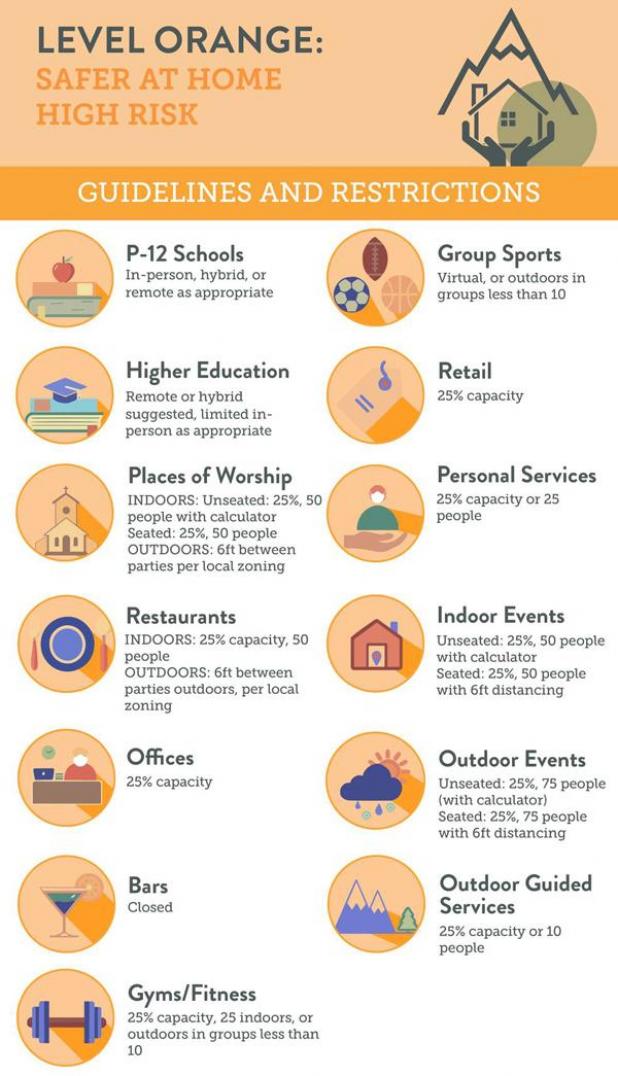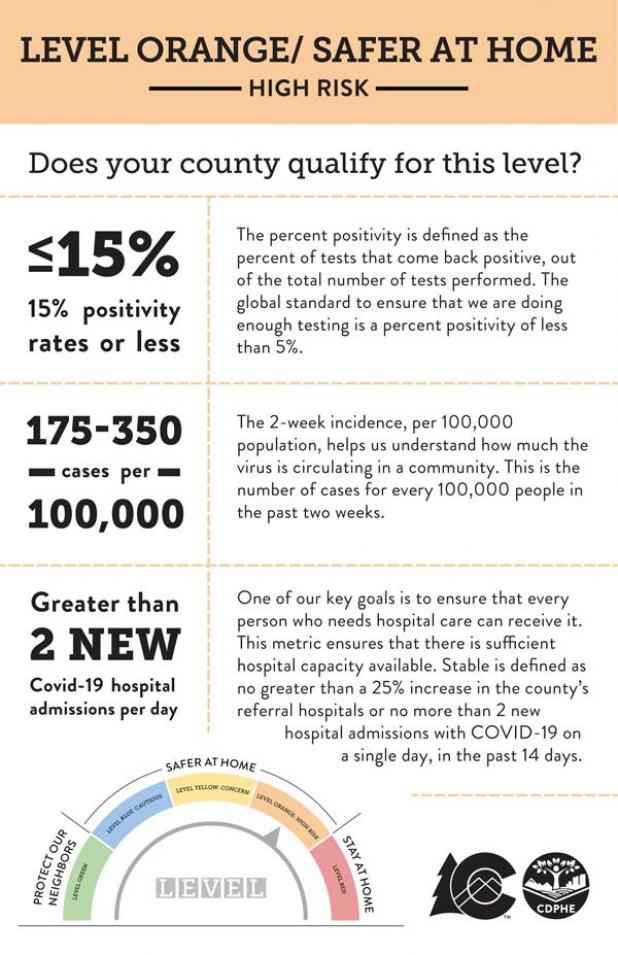County sees COVID surge
Phillips County was moved to Safer at Home — Level Orange: High Risk on Colorado’s COVID-19 dial effective Friday, Nov. 13, at 5 p.m. Yuma County is the only northeast Colorado county that is in Safer at Home — Level Yellow: Concern. The rest are at the same level as Phillips County.
Colorado Department of Public Health & Environment makes adjustments to counties’ levels based on:
— New cases per 100,000 people.
— Percent positivity.
— Impact on hospitalizations, especially whether they are increasing, stable or declining.
In order to move to a less restrictive level, counties have to meet and remain compliant with all three metric parameters for two weeks. The counties then have a consultation with CDPHE to discuss further actions.
Counties in level orange on the COVID dial are not eligible for any variances to the restrictions, which only become potentially available at level yellow for outside gatherings.
Many of the capacity levels on level orange allow only for gatherings that are at 25% capacity or 50 people, whichever is fewer.
“What’s happening to us is what was being predicted in March,” Phillips County Emergency Manager Bob Heldenbrand said. “Now it’s really here. We have to take action on it. Everybody’s having to adapt and make changes.”
He went on to point out that facilities are adapting to new protocols, and he asked the community to follow the guidelines and precautions.
He emphasized the importance of protecting the vulnerable in our county, specifically those already hospitalized or in extended care facilities. He said it is of critical importance to follow those establishments’ safety guidelines and to help keep patients, residents and health care workers safe.
Chairman of the Board of Phillips County Commissioners Terry Hofmeister said it’s very important that the public understands how serious this is.
“It’s not a joke,” he added.
Hofmeister pointed out how incredibly helpful Northeast Colorado Health Department has been during this process, specifically in helping with the numbers and metrics, offering guidance, educating the public and conducting contact tracing. Hofmeister said they have calls with NCHD on a regular basis to coordinate efforts and can increase the frequency if ever deemed necessary.
“They’ve played a great supportive role,” Heldenbrand added.
Hofmeister and Heldenbrand went on to emphasize that it’s going to really take the entire community to come together to try to reverse these numbers.
“All the agencies in Phillips County have really pulled together, and it really shows that they care,” Hofmeister said. “We need to take care of ourselves and take responsibility.”
Hofmeister pointed out that there are already signs of the community coming together.
“I’m very proud of our community and the multiple agencies coming together to help our neighbors,” he said, referring to Melissa Memorial Hospital and Haxtun Health coordinating to help take patients from Logan County and treat them in MMH. The patients have since been discharged.
Heldenbrand said one of the gravest concerns is overloading hospitals. He said it’s becoming more challenging to transfer patients to a higher care facility since Front Range hospitals are filling up.
He continued, saying that it’s important to get beyond the political element in this matter, as the virus does not know politics and makes no distinctions.
“This is just a whole new world,” he said. “This can impact us for a long time.”
Both Hofmeister and Heldenbrand urged people to take the issue seriously and to be responsible with the holidays approaching, as gatherings could increase the spread of the disease.
MMH experiencing patient surge
MMH Chief Executive Officer Cathy Harshbarger said the first wave of COVID-19 involved learning about the disease, but now there’s a patient surge.
She said positive COVID cases have gone up significantly in the area.
They are performing no fewer than 25-30 tests in a given day, and some days they perform 120-130 tests.
“Most days we have 50% positive,” she said, noting that sometimes that percentage is even higher.
She said people should get tested when they’re experiencing symptoms like fever, shortness of breath, cough and fatigue that are worsening. Curbside testing, which takes about 15 minutes, is available. People should call ahead to schedule a test.
“Our community has been great to the hospital and our staff,” she said.
The virus is having an impact on MMH staff, too. As of Monday, Nov. 16, she said six staff members were out due to testing positive for COVID-19 and two had positive cases in their households. The cardiac rehab, physical therapy and occupational therapy departments are closed, and no surgeries are being performed.
Harshbarger pointed out that although health care workers are feeling an emotional toll, they have really risen to the occasion, adding that staff members have been working extra shifts and overtime. “We care about the community and are grateful for our community members. We want to see them take care of themselves and stay safe.”
She pointed out that about 2% of Coloradans have contracted COVID-19 and died, adding that although 577 Coloradans died from flu in the 2017-18 flu season, over 2,000 and counting having died from COVID since March.
She added that this is not political, but the reality of COVID, emphasizing that people should wear masks, practice social distancing and wash hands frequently.
“It’s impacting our community, and it’s serious,” Harshbarger said. She also said that many people have complications from COVID, such as lung tissue scarring, that can last the rest of a person’s life. She called on community members to take matters into their own hands and follow the safety protocols. People can be asymptomatic and still have COVID, and she urged people to think of their neighbors, especially the elderly, immunocompromised and other populations at greater risk for complications.
“Think about what’s important for you to be doing,” she said, pointing out that the peak in cases could occur sometime between Dec. 31, 2020, and Jan. 15, 2021. And with the holiday season approaching and people gathering, the number of cases could climb.
Harshbarger said MMH is very committed to taking on patients that need it. She said MMH is at surge capacity. They are licensed for 15 beds, but they have a waiver from the state that means they can have up to 30 beds.
She said MMH usually has a 2-4 patient census, but it has increased to 15-19. Harshbarger acknowledged that they have plenty of personal protective equipment, but hospitals that MMH normally sends patients to are approaching capacity, meaning it can be harder to rely on neighboring hospitals as they’re experiencing capacity issues.
MMH also has a total of six ventilators. Three are transport ventilators, and three are long-term ventilators. One of the long-term ventilators is on loan from Kiowa County. The long-term ventilators are much more sensitive than the transport ventilators, allowing for more specific calibration of the instruments.
“I want our community to partner with us on masks and distancing so we can continue to take care of the community,” Harshbarger said. “You can help us by protecting yourself and others.”
Vaccine preparation underway
On a media call Friday, Nov. 13, NCHD provided updates and guidance regarding COVID-19.
They said they were seeing increases in positive cases in all northeast Colorado counties but Yuma, and these increases are their largest concern.
NCHD echoed what Harshbarger and Heldenbrand said, pointing out that increasing numbers can overwhelm health care staff and cause a delay in finding a receiving hospital to transport a patient to if a higher level of care is needed.
NCHD provided an update in terms of COVID-19 vaccines. Vaccine development and distribution is a large undertaking at all levels. Some are nearing the end of their phase three trials.
The Pfizer vaccine is a two-dose series, where a patient takes the second dose three to four weeks after the first. The vaccine requires cold storage at temperatures between -60 and -80 degrees Celsius.
NCHD works with state and local officials to come up with point of dispensing and mass-vaccination plans. They are making plans for limited doses of the vaccine in mid-to-late December, making sure to target health care workers, first responders and long-term care residents first. They then expect increased availability of the vaccine in late winter through the spring.
Until wide availability of a vaccine, NCHD urged people to be mindful of their actions and plans, especially with the holidays approaching.


